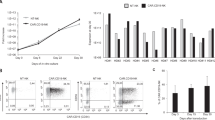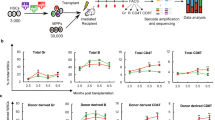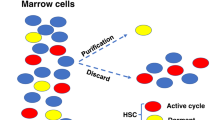Abstract
The feasibility of using the enhanced green fluorescent protein (EGFP) as a selectable reporter molecule of retroviral-mediated gene transfer in immature rhesus monkey and human CD34+ hematopoietic cells was examined. Retroviral transduction with the MFG-EGFP retroviral vector resulted in readily detectable EGFP expression in 27% of human and 11–35% of rhesus monkey bone marrow cells, and in 17–38% of rhesus monkey peripheral blood cells mobilized with FLT3 ligand (FL) and granulocyte colony-stimulating factor (G-CSF). In addition, we used the human CD34+ KG1A cell line as a model to study viability and growth of successfully transduced cells. Cultures of mock- and EGFP-transduced KG1A cells generated equal viable cell numbers for at least 1 month, indicating the absence of a cytotoxic effect of EGFP expression in these cells. FACS selection on the basis of EGFP and CD34 expression resulted in enriched subsets (⩾87%) of CD34+ EGFP-negative and CD34+ EGFP-positive KG1A, rhesus monkey and human bone marrow cells, demonstrating the potential of obtaining almost pure populations of transduced immature hematopoietic cells. EGFP expression was also readily demonstrated in erythroid and granulocyte/macrophage colonies derived from the CD34+ EGFP-positive rhesus monkey and human bone marrow cells by either inverted fluorescence microscopy or flow cytometry. Using four-color flow cytometry, EGFP expression could also be demonstrated in viable and phenotypically defined immature subpopulations of the CD34+ cells, ie those expressing little or no HLA-DR (rhesus monkey) or CD38 (human) antigens at the cell surface. These results demonstrate that EGFP is a very useful marker to monitor gene transfer efficiency in phenotypically defined immature rhesus monkey and human hematopoietic cell types and to select for these cells by multi-color flow cytometry prior to transplantation.
This is a preview of subscription content, access via your institution
Access options
Subscribe to this journal
Receive 12 print issues and online access
$259.00 per year
only $21.58 per issue
Buy this article
- Purchase on Springer Link
- Instant access to full article PDF
Prices may be subject to local taxes which are calculated during checkout
Similar content being viewed by others
Author information
Authors and Affiliations
Rights and permissions
About this article
Cite this article
Bierhuizen, M., Westerman, Y., Hartong, S. et al. Efficient detection and selection of immature rhesus monkey and human CD34+ hematopoietic cells expressing the enhanced green fluorescent protein (EGFP). Leukemia 13, 605–613 (1999). https://doi.org/10.1038/sj.leu.2401374
Received:
Accepted:
Published:
Issue Date:
DOI: https://doi.org/10.1038/sj.leu.2401374



